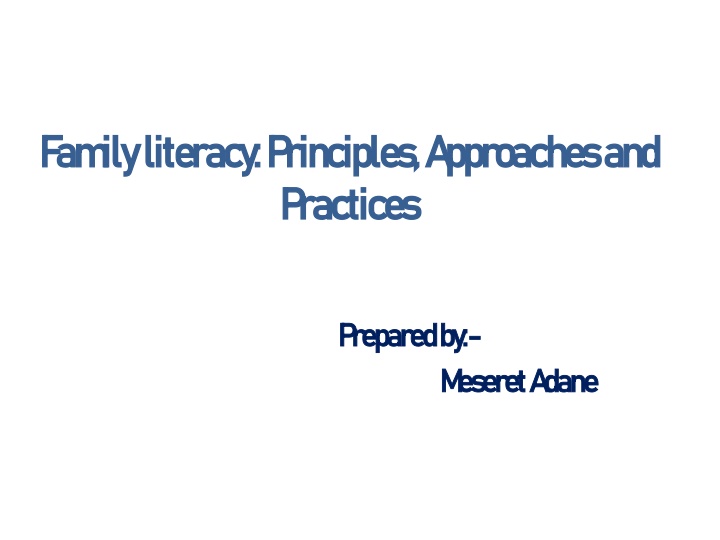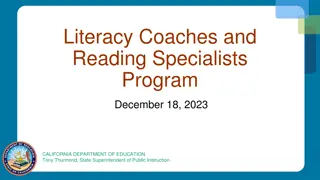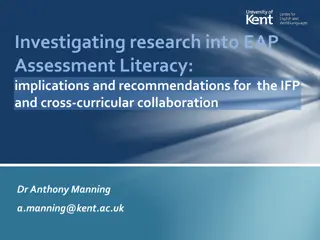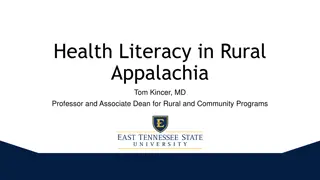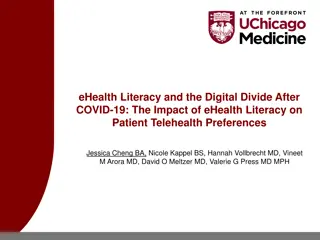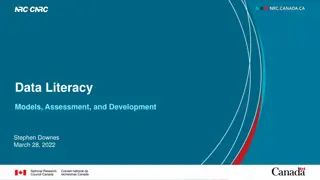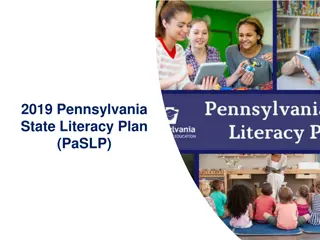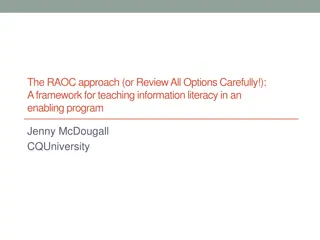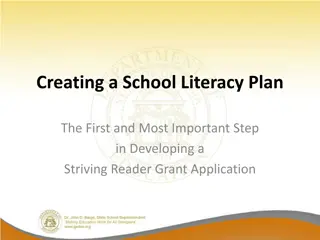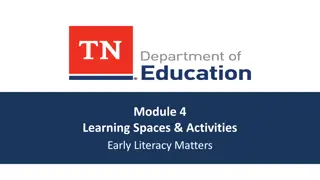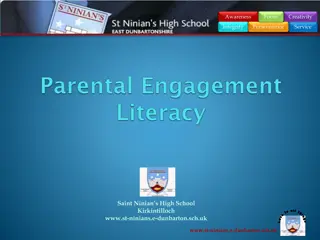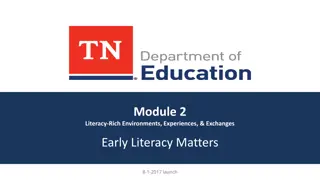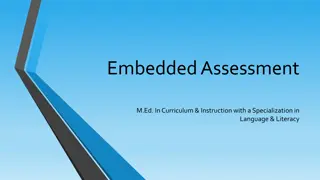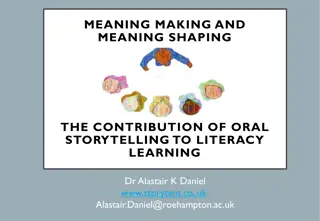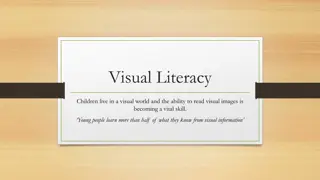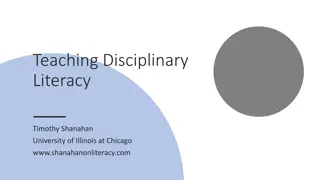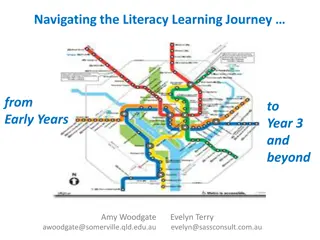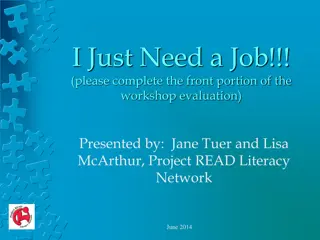Family Literacy: Principles and Approaches
Family literacy is about promoting literacy skills within families through intergenerational interactions, encompassing a range of programs aimed at different groups and settings. It emphasizes the transfer of language and literacy from parents to children, creating a rich home literacy environment beneficial for children's learning. Family learning involves activities for both children and adult family members, fostering a culture of learning within the family unit.
Download Presentation

Please find below an Image/Link to download the presentation.
The content on the website is provided AS IS for your information and personal use only. It may not be sold, licensed, or shared on other websites without obtaining consent from the author.If you encounter any issues during the download, it is possible that the publisher has removed the file from their server.
You are allowed to download the files provided on this website for personal or commercial use, subject to the condition that they are used lawfully. All files are the property of their respective owners.
The content on the website is provided AS IS for your information and personal use only. It may not be sold, licensed, or shared on other websites without obtaining consent from the author.
E N D
Presentation Transcript
Fam ily literacy: P rinciples, A pproaches and Fam ily literacy: P rinciples, A pproaches and P ractices P ractices P repared by: P repared by:- - M eseret M eseretA dane A dane
C hapter One C hapter One The C oncept of Fam ily L iteracy There is no single and officially accepted definition of the term family literacy . For instance According to UNESCO (2008a) Family literacy is an approach to learning that focuses on intergenerational interactions within families and communities which promote the development of literacy and life skills. Family literacy celebrates and builds on existing skills and knowledge, and encourages participants to identify issues they face within their families and communities and to act upon them.
Cont Family literacy emphasizes the intergenerational transfer of language and literacy from parents to their children or from one generation to another. A range of family literacy programmes exists, varying according to the groups at which each is aimed. Some programmes focus on children, some on adults, and others on both. Some programmes are run at home, some in schools or other educational institutions, and others in community centres. Some programmes have a strong focus on literacy and language, others are based on broader concepts involving health, parenting and life skills.
Cont According to Pelt (2018) Family Literacy is a type of literacy that emphasizes bringing reading and writing into the home and making it a family activity. According to a study conducted by the National Center for Education Statistics, children with a richer home literacy environment displayed higher levels of reading knowledge and skills than did their counterparts with less rich home literacy environments. Family literacy is imperative in creating a foundation for children s learning experiences, and it all starts with the parents The term family literacy can be used to refer to literacy practices within families as well as to describe an intergenerational educational programme with a focus on literacy (UNESCO, 2008b).
Cont Family learning refers to any learning activity that involves both children and adult family members, where learning outcomes are intended for both, and that contributes to a culture of learning in the family (National Institute of Adult Continuing Education, 2013).
Cont Family Learning encourages family members to learn together as and within a family, with a focus on intergenerational learning. Family learning activities can also be specifically designed to enable parents to learn how to support their children s learning. Family learning is a powerful method of engagement and learning which can foster positive attitudes towards life-long learning, promote socio- economic resilience and challenge educational disadvantageous families (Scottish Family Learning Network, 2016)
Cont Family literacy refers to the development of the literacy, numeracy and language skills of both children and adults. Family literacy programmes address the learning needs of an entire family rather than individuals in isolation. Family literacy should be a core element of all intergenerational learning (UNESCO, 2017).
Cont PRLN (project Read Literacy Network Waterloo) defines family literacy programming as: Programs that focus on improve the already-present strengths within families by working with the parents to aid in their child s literacy skills and their own literacy skills. By using supports from adult literacy, early childhood education, and family support, family literacy programs help parents to support their children as they develop literacy and math skills that will provide a foundation for the child s future success. The programs proactively provide emotionally-centered and relationship-based strategies in which parents learn to support and mentor their children in daily activities in order to create lifelong learners.
Cont Family literacy focuses on parents, grandparents and other family members to improve the reading and writing skills of the whole family. By reading to children and engaging in fun literacy activities regularly, adults actively keep their own skills sharp and also help children improve their skills. Family literacy activities strengthen the relationship between family members which, in turn, encourages lifelong learning. Without adult support and a strong foundation at home, a child is less likely to be successful and engaged in school.
The key elements of family literacy The International Reading Association (IRA) Commission on Family Literacy, identified the following key elements involved in family literacy: Family literacy encompasses the ways parents, children, and extended family members use literacy at home and in the community. Family literacy occurs naturally during the routines of daily living and helps adults and children get things done . Family literacy activities may reflect the ethnic, racial, or cultural heritage of the families involved.
Cont Examples of family literacy might include using drawings or writings to share ideas; composing notes or letters to communicate messages; keeping records; reading and following directions; or sharing stories and ideas through conversation, reading, and writing. Family literacy may be initiated purposefully by a parent, or may occur spontaneously as parents and children go about the business of their daily lives.
Cont Family literacy activities may be initiated by outside institutions or agencies. These activities are often intended to support the acquisition and development of school-like literacy behaviors of parents, children and families. Family literacy activities initiated by outside agencies may include family storybook reading, completing homework assignments, or writing essays or reports.
The nature of fam ily literacy Simpson (2003) state the unique nature of family literacy, as described here, is the three-fold approach to programming: 1. Family literacy programs seek to encourage and support parents in their role as the first teachers for their children. This is done as program leaders affirm the literacy activities parents do naturally through daily routines at home, share information about ways to extend and enrich literacy learning for babies, toddlers and pre-school children, and encourage discussions about other parenting issues;
Cont 2. Family literacy programs enrich children s literacy development through regular circle times involving stories, rhymes, songs, alphabet games and phonemic awareness activities. Sharing books, playing with literacy and other learning materials, and interacting with caring adults will encourage children s growing self-confidence, and develop positive attitudes towards books, language and learning;
Cont 3. Family literacy programs provide shared literacy experiences for parents and children to enjoy together.
The objectives of Family literacy To support teachers and parents in preventing school failure and drop-out. Address the low literacy achievement of many primary school children and the lack of confidence of parents/community members in their ability to provide support to these children. To address the intergenerational effects of poor literacy and to raise literacy standards across the generations. Helping the parents to provide some concept about how to support their children's learning. To enable adults and children to learn together. To raise standards of literacy for both parents and children, to extend parents skills in supporting their children s developing literacy skills, and to provide opportunities for parents to achieve literacy qualifications at an appropriate level.
P rinciples of fam ily L iteracy The idea of families learning together exists around the world. In the 1980s research began to include the role of the family in the context of literacy development. Denny Taylor advocated for change in how family literacy programs are defined. In the book Many Families, Many Literacies: An International Declaration of Principles (1997) she outlined principles of family literacy that still hold true today Families are diverse and should not be narrowly defined. Families are both biological and social, span generations, and include members who live apart from their biological family
Cont Literacy is found in everyday activities that are a part of family life and is not usually the focus of the activity, but a result of things that are done. Families should be supported in their role as a child s first and most important teacher. Family members, both adults and children, should have an opportunity to learn in their first language. When planning literacy programs, parents and caregivers should be active in the decision-making process. The wisdom and strength of each family is shaped by their culture, language, and home life. When every family is valued, society benefits
The Benefits of family Literacy Family learning produces multiple outcomes for parents, children, families and communities. A wide range of evidence shows family learning to be an effective way of promoting and facilitating increased parental participation and engagement with the school (Mackenzie, 2010). Family learning has also shown to improve school attendance, reduce persistent absenteeism and improve pupils attainment.
Cont Wider outcomes are shown through skills development, employability, progression into work, interactions within the family, as well as improvements in parental confidence and parenting skills. Learning outcomes and benefits resulting from family learning can be categorized into five areas: new skills; increased confidence and understanding; improved communication; changed behaviors; and changed relationships with the community and family. Family learning outcomes can be varied within a programme and individuals within the family.
H ow children benefit from fam ily literacy program s? H ow children benefit from fam ily literacy program s? o To promote their children s literacy development. o Family literacy programs have a significant impact on children s cognitive skills, including language, literacy, and numeracy. o Family literacy programs can positively affect children s motivation, their behavior, and their self-esteem and self-confidence. o Family engagement in children s learning has an overall positive impact on their achievement in school. o Parent involvement in literacy instruction has a significant, positive impact on children s reading acquisition.
H ow parents benefit from fam ily literacy program s? H ow parents benefit from fam ily literacy program s? For many adult learners, family literacy programs offer a rare opportunity: space and time to forge new identities, to develop or recover literate and academic abilities, and to pursue dreams for themselves and their families. Benefits of family literacy programs to parents can include: - Parents learn to support their children s learning They place greater value on education and learning and gain a better understanding of school systems They become more interested in developing their own literacy skills They have opportunities to progress to further education and training.
Cont Parents in family literacy programs can become more comforable at school, understand school expectations better, and be better able to support their children s learning at home. To help parents gain literacy knowledge and skills that they incorporate in daily interactions with their children. Parents learn skills that help them develop more effective parenting strategies.
C ategorizing fam ily literacy program s Nickse classified programs according to the type of participant (adult and/or child) and the degree of intervention (direct or Indirect). The degree of intervention refers to "whether or not the adult and the child are present together for literacy development any or all of the time" (Nickse 1989, 29). "Primary" participants receive direct services, "secondary" participants benefit indirectly
1. D irect adult / direct child P rogram m ing 1. D irect adult / direct child P rogram m ing This model involves programming for both parents and pre-school child. Parents attend literacy instruction and may participate in parenting education, vocational training, or volunteer in the program or children's classroom. "Parent and child together" activities are also a key feature, and may include instruction on how to interact and play with children, as well as how to read to them. Programs use a dual curriculum and direct instruction that is class-based. Children take part in a structured early childhood or preschool program.
2. D irect adult / indirect child 2. D irect adult / indirect child Adults are the main focus and children are not involved on a regular basis. 3. Indirect adult / direct child 3. Indirect adult / direct child Preschool and school-aged children are primary recipients. Parents may be invited to participate but usually do not receive literacy education and support for their own needs.
4. Indirect adult / indirect child 4. Indirect adult / indirect child Indirect adult / indirect child -Adults and children together. The goal is the promotion of literacy practices such as reading for enjoyment. Examples: library story times, Reading Buddies programs, book talks.
C hapter Tw o C hapter Tw o Success Factors in Fam ily L iteracy Success Factors in Fam ily L iteracy There is a sound body of evidence suggesting that successful family literacy programmes respond to the needs and concerns of learners, have adequate long-term funding, and are committed to strong partnerships (NationalAdult LiteracyAgency, 2004).
Cont According to the findings of a recent study produced for the European Commission, four key factors shape the long-term success of family literacy programmes: programme quality; 2) partnerships; 3) research-based evidence of achievement; and 4) funding (Carpentieri et al., 2011). 1) Some programmes have also cited media support as a fifth factor for sustainability. According to this study, reading and learning must be natural and fun, but this requires a cultural shift.
Cont Therefore national famliy literacy programmes must be flexible enough to meet local and individual family needs. Parents and caregivers have an active role to play in supporting their children s learning and development, and the home environment is crucial.
Cont An international seminar on family literacy held by the UNESCO Institute for Lifelong Learning and the University of Hamburg in 2009 identified the following elements of good practice for successive family learning program Promoting collaboration between different institutions and stakeholders Building on literacy practices and strengths already present in families and communities Responding to the needs and interests of participating families
Cont An international seminar on family literacy held by the UNESCO Institute for Lifelong Learning and the University of Hamburg in 2009 identified the following elements of good practice for successive family learning program Promoting collaboration between different institutions and stakeholders Building on literacy practices and strengths already present in families and communities Responding to the needs and interests of participating families
Cont Demonstrating cultural and linguistic sensitivity in the use of resources and learning strategies Celebrating and emphasizing the joy of learning Using sound educational practices appropriate for the literacy development of children and adults Employing highly dedicated, qualified and trained staff Providing accessible and welcoming locations Helping learners to overcome barriers to participation Establishing ongoing, manageable monitoring and evaluation processes that produce information useful for programme improvement and accountability
Some of the challenges that family literacy and learning programmes face include: o Low Motivation of disadvantageous families to participate and remain in family literacy programmes o Tackling limited or poor literate environments o Difficult to delivering for multilingual contexts o Limited access of resources for meeting diverse needs of the family o Negative attitudes and low professional development of the staff o Difficult developing a sense of ownership among communities and target groups
Intergenerational learning Intergenerational learning (IGL) is informal and multi-generational and typically involves learning that takes place naturally as part of day-to-day social life. A more formal definition of IGL, which captures today s usage of the term, is: A learning partnership based on reciprocity and mutuality involving people of different ages where the generations work together to gain skills, values and knowledge
Cont Intergenerational learning (IL) is defined by the European map of intergenerational Learning (EMIL) as: The way that people of all ages can learn together and from each other. IL is an important part of Lifelong Learning, where the generations work together to gain skills, values and knowledge. Beyond the transfer of knowledge, IL fosters reciprocal learning relationships between different generations and helps to develop social capital and social cohesion in our aging societies.
Cont Intergenerational Learning refers to learning of knowledge and skills between two generations for the benefit of each other as well as of society. Family remains the key socialization factor through the life course; intergenerational learning plays an important role in this process. Intergenerational learning in the family involves intentional and unintentional learning activities and exchange of experiences amongst generations;
Cont Intergenerational learning is based on reciprocity and cooperation between young and old, which results in variously strong ties between the generations and in a benefit of one or both groups. It is intergenerational family socialization, which can be defined as lifelong mutual influence between generations inside the family, occurring in changed social and historical circumstances; it involves (both-way) intentional and unintentional transmission of positions and behavior between generations
Cont IGL so relevant and necessary now? Children and older adults are spending more time in age segregated settings such as early childhood education and care (ECEC) centres and care centres for older adults. There is also more migration separating grandparents from grandchildren. These make it difficult to maintain the traditional form of learning between generations.
Cont... A growing age diversity in society and new family forms means that new approaches and activities are needed to maintain contact between generations. IGL is now considered an important part of Lifelong Learning. In addition to the transfer and exchange of knowledge, IGL fosters reciprocal learning relationships between different generations as well as helping to develop social capital and social cohesion.
The Benefits of Intergenerational Learning For youth and children it can improve academic performance and older adults can learn new information and technologies. In general, the breadth and depth of learning improves. Culture, values and traditions can be passed on. Due to the age diversity, the learning is rich in information and experiences. Generations working together stimulate the creative processes and open up the exploration of ideas.
Cont Intergenerational learning develops mutual learning relationships between different generations and helps to develop social capital and social cohesion. Each generation learns about the other and gains a better understanding of the other generations strengths, fears, and weaknesses. Each generation has resources which are of value to the other and share areas of concern which aids in providing a sense of empowerment.
Cont Reciprocity within intergenerational learning refers to the exchange of knowledge and skills across generations. IGL helps For the young learner: a transfer of traditions, values, and culture and life-time skills. For the older learner: a transfer of new values, insights about traditions, changing social structures and new technology.
Cont Newman (1997) and Kaplan (2002) stress the importance of intergenerational learning as two-way learning, that is adults-to-children and vice versa. The process is a function of the environment, the structure and goals of the model. As a global concept, intergenerational learning can be adapted to function in multiple societies through a variety of learning strategies.
Cont Empowerment within intergenerational learning is an intentional ongoing process centered in the local community involving mutual respect, critical reflection, caring and group participation through which people lacking an equal share of resources gain greater access to these resources (Lawrence, 2006).
Cont Empowerment theory is compatible with intergenerational learning and community building (social capital) initiatives. With a growing world interdependence, it is becoming more evident that intergenerational learning as the intergenerational exchange of knowledge and skills can become a vital adaptation strategy for young and old in the knowledge society of the 21st century (Hoff, 2007). Intergenerational learning can provide a foundation for life long learning from a social capital perspective in which various aspects of social life create synergy and provide cohesive trust and solidarity (Bostrom, 2007).
Mobile Family Literacy Children, even very young ones, are experiencing a technologically rich home environment. This enables children to learn how to use technology, as well as developing their knowledge of the world from the content of the media accessed.
Parental Influences and Child Technology Use Parents own use of media, rather than their attitudes concerning their child s use, may be a key determinant of children s use. Parents need to fully appreciate the potential consequences of their mediation practices as well as their own behavior. A homework activity is one area for collaboration between parents and children based around technology use. Whilst formal schooling may provide a foundation for digital literacy skills in children, the influence of parents own use of technology within the home complements their children s formal learning. However, a major barrier to the development of shared practices is parents potential lack of basic digital skills.
Cont It is no longer sufficient to be able to read a book and write with a pen: one also needs to be able to access and read information online and respond appropriately. These abilities are captured by the concept of Digital Literacy that can be defined as The skills, knowledge and understanding that enables critical, creative, discerning and safe practices when engaging with digital technologies in all areas of life (Futurelab, p. 8). Given the influence that parents exert over children, this skills gap requires urgent attention if children are to learn how to use new technologies responsibly and safely in their home environment.
Cont The use of mobile digital devices is deeply embedded within the many informal familial contexts that a child inhabits, and that their use of these devices is influenced by the practices of the other individuals who co-inhabit those spaces. These include parents, siblings, classmates and friends and their influence may be exerted in a number of ways, some of which may be deliberate, however, some are not. Parents often underestimate the powerful influence their use of technology has on their child. The question then is why does this happen? A frequent form of learning used by children is observational learning where behaviors are observed and then imitated.
